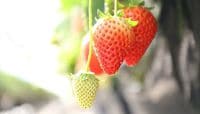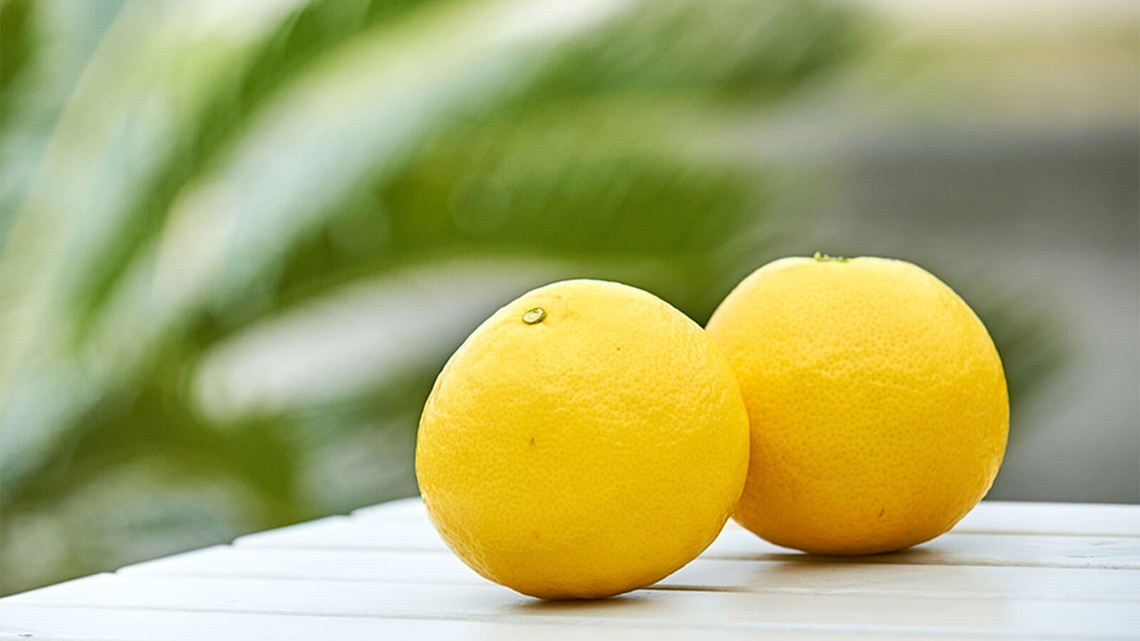

Hyuganatsu is a citrus originating from Miyazaki, a prefecture with a temperate climate and famous for many kinds of fruit. Hyuganatsu also comes with a unique story; about 200 years ago, it was accidentally found naturally growing in someone’s garden.
Hyuganatsu is now grown in coastal regions of Miyazaki. Aya, situated in the mid-western part of Miyazaki, is known across Japan as a town dedicated to organic farming. What will the hyuganatsu citrus taste like when combined with Aya’s fertile lands? We visited the town for a story about the sun-kissed, vividly yellow hyuganatsu citrus while they were in their peak season.
Aya, farming organic for over 30 years
Miyazaki has a temperate climate throughout the year and has one of the highest number of sunlight hours and sunny days in Japan. In this prefecture, the town of Aya has wholly devoted itself to organic farming for over 30 years.
In 1988, the town single-handedly enacted a regulation to promote natural and ecological farming, and started organic farming with as little insecticides and chemical fertilizers as possible. The town has maintained this style ever since and is known across Japan as the pioneer of organic farming.
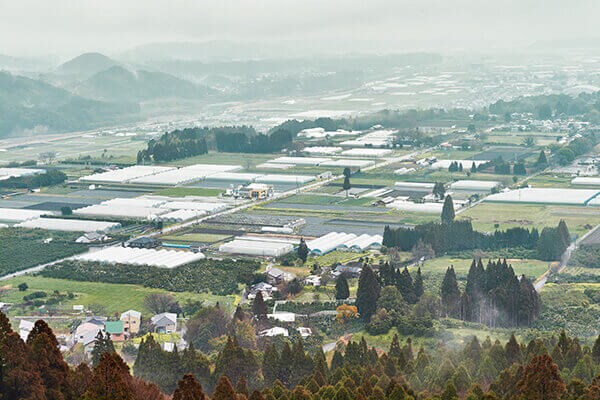
About 80% of Aya is covered in forest. It also has water sources that have been selected to produce one of the best 100 waters of Japan. Blessed with such a richly natural environment, the products grown from the town, which include fruits like hyuganatsu, mangoes, kinkan citrus, vegetables like cucumbers and livestock like beef and pork, are all highly rated and branded as “Aya products.” Naohiko Fukada, an officer in charge of branding at the Miyazaki prefectural office, told us why this town is so great.
“We have many visitors from both inside and outside Miyazaki Prefecture buying our agricultural and livestock products. We don’t just have forests and clean water. We also have a beautiful starry sky, which has been selected as one of the 100 best starry skies of Japan. Recently, more people are moving here from outside the prefecture, attracted to this environment. The farmers are also very devoted, working together on organic farming. Nowadays, people know farming techniques that do not interfere with the natural eco-cycle, but when we started organic farming, Japan was in the middle of a period of excess eating. The town mayor had great foresight to start organic farming in such times.”
The best hyuganatsu citrus are grown outdoors and sold in late spring
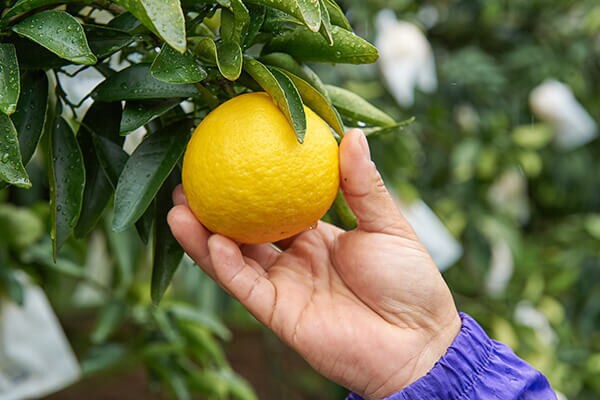
The name hyuganatsu (“natsu” meaning “summer”) might make you think its peak season is in the summer, but the peak season for hyuganatsu grown outdoors starts in March.
When we visited the orchard of farmer Kenji Hanada, there were many trees growing on the mountain slope, bearing many hyuganatsu just waiting to be picked.
Hanada grows the fruit in both greenhouses and the outdoors. “We ship the greenhouse hyuganatsu in February to March and the outdoor hyuganatsu between March and early May. We pick roughly over 20 tonnes a season. The best ones are, of course, the indigenous variety grown outdoors. You may find them bothersome to eat because they contain many seeds, but those are the ones with the original taste of the hyuganatsu. Even if they have a high sugar level, they also need to be sour. The important thing is the balance between the sourness and sweetness,” says Hanada.
Hyuganatsu trees bear flowers in mid-April, and after pollination, they begin to bear fruit. In the hot temperatures of August, each fruit has to be covered with a bag to prevent scarring and grow to become plump fruit under the warm sun. In accordance with Aya’s regulations, Hanada does not use any herbicides in his orchard. As Aya has active livestock farming, people use manure to maintain their soil.
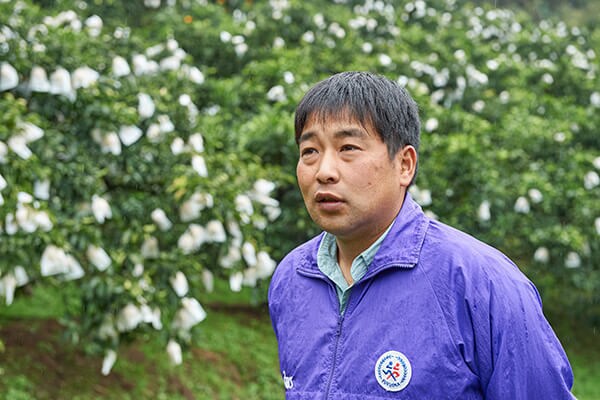
“Nature largely determines how the hyuganatsu grow. If we have too few hours of sunlight, or too little rain, the fruit will not become large enough. We also have frequent typhoons that can snap the branches. Since we don’t use herbicide, we are busy weeding the orchard, but I have never thought of it as hard work. We work on the fruit every day, telling them to become tasty (laughs).”
The white pith is concentrated hyuganatsu goodness
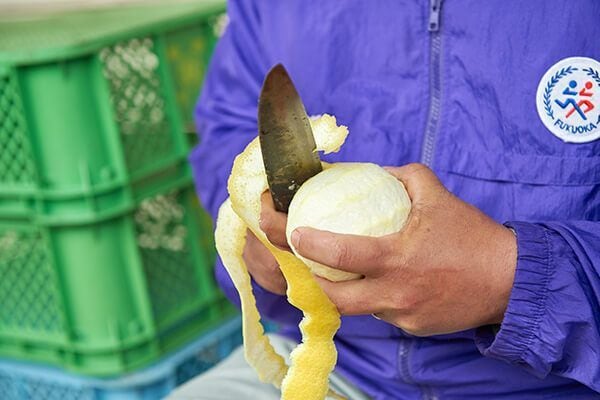
To enjoy hyuganatsu, one needs to know how to cut it correctly because, unlike other types of citrus, the best way to enjoy hyuganatsu is to have it with the white pith around the fruit. We asked Hanada to show us how to cut it.
First, he peels the outer yellow zest like he would an apple, leaving the white pith intact. The remaining fruit is cut into slices. Apparently, you don’t eat the middle, seed-filled part. The final slices are beautiful, with the white pith lining the contrasting yellow color of the flesh.
“The yellow flesh is very sour and the flavor is just right when eaten with the sweet white pith. It tastes good as is, but the people of Miyazaki eat it with soy sauce or mix it in salads, because it goes well with all kinds of seasonings,” says Hanada.
When we ate it, the rind tasted sweet, as Hanada had said, and was well-balanced with the sour and juicy yellow flesh. It also had a strong scent with a long-lasting, refreshing taste that seemed to linger forever in our mouths. It smelled so amazing. When we asked, we found out that hyuganatsu is apparently a distant relative of the Yuzu,
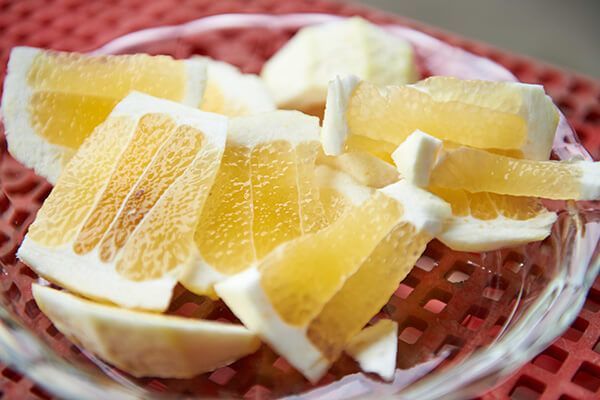
“A few times a year we put out and sell our hyuganatsu so we can be face to face with our customers, I find that to be the most fun part of this. I am so happy when people eat our hyuganatsu in front of us say that it is delicious. Especially when it comes from a child, because they are honest about their opinions on taste,” chuckles Hanada.
We invite our readers to savor the hyuganatsu citrus, a fruit that looks like the sun, grown with the blessings of Aya’s natural environment.
(Writer : ASAKO INOUE / Photographer : YUTA SUZUKI)


